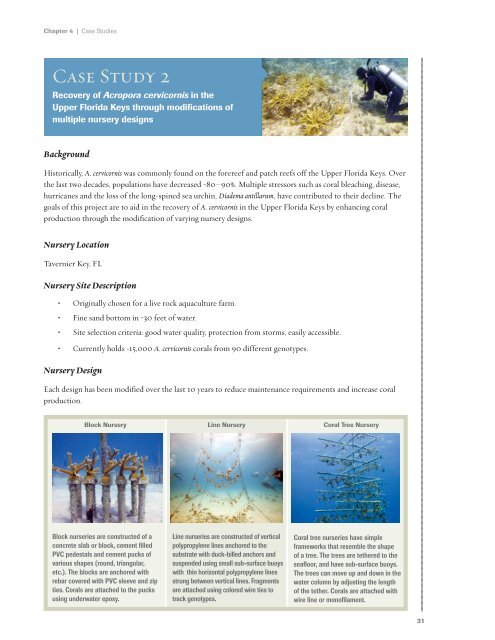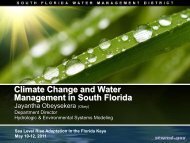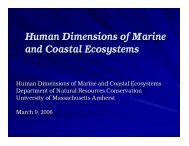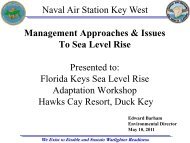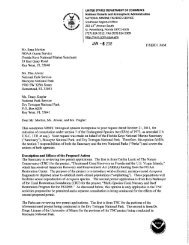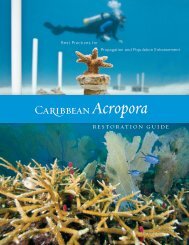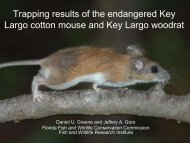Caribbean Acropora Restoration Guide - The Florida Reef ...
Caribbean Acropora Restoration Guide - The Florida Reef ...
Caribbean Acropora Restoration Guide - The Florida Reef ...
Create successful ePaper yourself
Turn your PDF publications into a flip-book with our unique Google optimized e-Paper software.
Chapter 4 | Case Studies<br />
Case Study 2<br />
Recovery of <strong>Acropora</strong> cervicornis in the<br />
Upper <strong>Florida</strong> Keys through modifications of<br />
multiple nursery designs<br />
Background<br />
Historically, A. cervicornis was commonly found on the forereef and patch reefs off the Upper <strong>Florida</strong> Keys. Over<br />
the last two decades, populations have decreased ~80–90%. Multiple stressors such as coral bleaching, disease,<br />
hurricanes and the loss of the long-spined sea urchin, Diadema antillarum, have contributed to their decline. <strong>The</strong><br />
goals of this project are to aid in the recovery of A. cervicornis in the Upper <strong>Florida</strong> Keys by enhancing coral<br />
production through the modification of varying nursery designs.<br />
Nursery Location<br />
Tavernier Key, FL<br />
Nursery Site Description<br />
• Originally chosen for a live rock aquaculture farm.<br />
• Fine sand bottom in ~30 feet of water.<br />
• Site selection criteria: good water quality, protection from storms, easily accessible.<br />
• Currently holds ›15,000 A. cervicornis corals from 90 different genotypes.<br />
Nursery Design<br />
Each design has been modified over the last 10 years to reduce maintenance requirements and increase coral<br />
production.<br />
Block Nursery Line Nursery Coral Tree Nursery<br />
Block nurseries are constructed of a<br />
concrete slab or block, cement filled<br />
PVC pedestals and cement pucks of<br />
various shapes (round, triangular,<br />
etc.). <strong>The</strong> blocks are anchored with<br />
rebar covered with PVC sleeve and zip<br />
ties. Corals are attached to the pucks<br />
using underwater epoxy.<br />
Line nurseries are constructed of vertical<br />
polypropylene lines anchored to the<br />
substrate with duck-billed anchors and<br />
suspended using small sub-surface buoys<br />
with thin horizontal polypropylene lines<br />
strung between vertical lines. Fragments<br />
are attached using colored wire ties to<br />
track genotypes.<br />
Coral tree nurseries have simple<br />
frameworks that resemble the shape<br />
of a tree. <strong>The</strong> trees are tethered to the<br />
seafloor, and have sub-surface buoys.<br />
<strong>The</strong> trees can move up and down in the<br />
water column by adjusting the length<br />
of the tether. Corals are attached with<br />
wire line or monofilament.<br />
31


